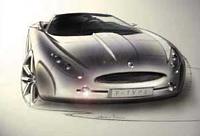The Jaguar F-TYPE roadster has been given the production go-ahead, the company announced today. The all-new, compact Jaguar roadster becomes the fifth model in the company’s expanding product range and marks Jaguar’s return to the true sports car market, which it helped to create in the 1950s and 1960s. Announcing the decision at the Los Angeles International auto show today, Jaguar’s Chairman, Dr. Wolfgang Reitzle, said, “Jaguar is one of the most evocative brands in the world and there is a renewed commitment at Jaguar to create cars that stir people’s emotions. The overwhelmingly positive reaction across the globe to last year’s concept has convinced Jaguar to build the F-TYPE roadster.”
“Due to the unprecedented growth and intensity of new product development at Jaguar today, it will take us around three years to deliver the F-TYPE roadster programme to market. While F-TYPE will embody all the passion and excitement of past Jaguar roadsters such as XK 120 and E-type, it clearly signals a fresh direction for Jaguar sports cars in the future.” The F-TYPE has been the subject of a detailed 12-month study to determine both the business implications and potential launch timing. A crucial issue for the study team was to determine the relative priority of F-TYPE in the context of the company’s ambitious long term product plan.
Today, Jaguar as a business is in the throes of a major product-led transformation. The introduction of the S-TYPE saloon in 1999 is driving record sales around the world. The new X-TYPE compact sports saloon which goes on sale later this year establishes Jaguar as a four-model line company, accelerating the company’s development from a niche player into a major competitor in the premium car segment.
The smaller, more affordable F-TYPE roadster complements the XK Series range of sports cars and will extend Jaguar’s product portfolio to five distinct model ranges— three saloons and two sports car models. F-TYPE will therefore continue Jaguar’s drive to make the brand more accessible and aspirational to a wider customer audience. Within each model range, innovative derivatives will provide greater customer choice.Jonathan Browning, Jaguar’s Managing Director, said ,”The atmosphere at Jaguar today is vibrant, exciting and challenging, as the rate of new product development continues at a dramatic pace. Over the next 36 months, Jaguar will launch 15 new or significantly revised products and power trains. F-TYPE will be the sixteenth. From a manufacturer that a mere three years ago had only a two- model line up, this represents a massive investment in design, engineering and manufacturing resource. Today, Jaguar is the fastest growing of all car manufacturers, but this growth is being managed very carefully to ensure that we sustain our quality standards and do not over-extend the Jaguar brand.”
Within this array of new model developments, the traditional Jaguar values of style, finely crafted interiors and effortless performance are being complemented by innovative technology and a renewed emphasis on sportiness and performance. This is reflected by the supercharged ‘R’ derivatives—the XJR and XKR—the ‘R’ Performance Options and, of course, Jaguar’s involvement in Formula One. F-TYPE will be the boldest expression yet of this ‘emotional engineering’, which characterises new Jaguar.
The decision to take F-TYPE from concept to production coincides with the fortieth anniversary of that seminal Jaguar sports car, the E-type, which was unveiled to universal acclaim at the Geneva show in March 1961. The E-type was the latest in a line of illustrious Jaguar sports cars from the SS 90 and 100 of the thirties, through the revolutionary XK 120 in 1948, to the XK 140 and 150 of the fifties. The race-bred E-type, hailed as one of the greatest automotive designs of all time, epitomised the mood of the ‘swinging sixties’. With F-TYPE, the goal of the Jaguar designers is to create an uncompromised roadster which evokes the spirit of the legendary E-type, but with a style that is both functional and contemporary.
Ian Callum, Jaguar’s Director of Design explains, ”F-TYPE represents one of the greatest design challenges in Jaguar history. It must capture the spirit, sensuousness and passion of the original concept, reflect Jaguar’s future direction and meet real world packaging and performance requirements. The challenge is to create a true 21st century successor to the E-type, the icon of the 60s”.





